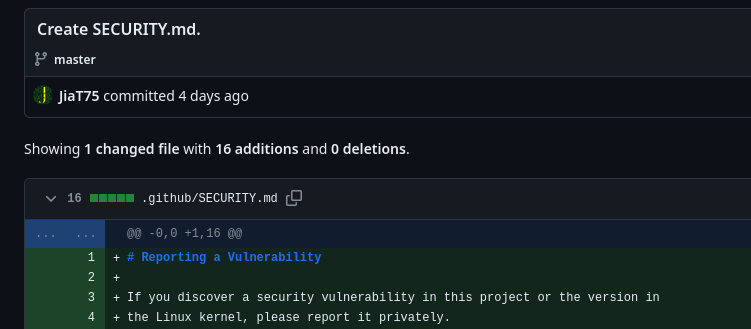Damn, it is actually scary that they managed to pull this off. The backdoor came from the second-largest contributor to xz too, not some random drive-by.
They’ve been contributing to xz for two years, and commited various “test” binary files.
It’s looking more like a long game to compromise an upstream.
Either that or the attacker was very good at choosing their puppet…
Well the account is focused on one particular project which makes sense if you expect to get burned at some point and don’t want all your other exploits to be detected. It looks like there was a second sock puppet account involved in the original attack vector support code.
We should certainly audit other projects for similar changes from other psudoanonymous accounts.
Yeah, and the 700 commits should be reverted… just in case we missed something.
That is a should be standard procedure
Time to audit all their contributions although it looks like they mostly contribute to xz. I guess we’ll have to wait for comments from the rest of the team or if the whole org needs to be considered comprimised.
deleted by creator
deleted by creator
It would be nice if we could press formal charges
Assuming that it’s just that person, that it’s their actual name and that they’re in the US…
there will be federal investigationjust speculation if the culprit is a foreign actorDo you have a source for this?
Source: they made it up
I don’t have a source but I think it is safe to say given the large corporations and government institutions that rely on XZ utils. I’m sure Microsoft, Amazon, redhat ect are in talks with the federal government about this
updated my post, it was just some speculation i misread
This is a fun one we’re gonna be hearing about for a while…
It’s fortunate it was discovered before any major releases of non-rolling-release distros were cut, but damn.
That’s the scary thing. It looks like this narrowly missed getting into Debian and RH. Downstream downstream that is… everything.
This is the best post I’ve read about it so far: https://boehs.org/node/everything-i-know-about-the-xz-backdoor
In the fallout, we learn a little bit about mental health in open source.
Reminded me of this, relevant as always, xkcd:

Yes, exactly.
And looking at you npm : npm
That whole timeline is insane, and the fact that anyone even found this in the totally coincidental way they did is very lucky for the rest of us.

If you’re using
xzversion 5.6.0 or 5.6.1, please upgrade asap, especially if you’re using a rolling-release distro like Arch or its derivatives. Arch has rolled out the patched version a few hours ago.Gentoo just reverted back to the last tar signed by another author than the one seeming responsible for the backdoor. The person has been on the project for years, so one should keep up to date and possibly revert even further back than just from 5.6.*. Gentoo just reverted to 5.4.2.
Just updated on void and saw the same thing
Dang, Arch never sleeps, does it? That’s a 24/7 incident response squad level of support.
Backdoor only gets inserted when building RPM or DEB. So while updating frequently is a good idea, it won’t change anything for Arch users today.
No, read the link you posted:
Arch does not directly link openssh to liblzma, and thus this attack vector is not possible. You can confirm this by issuing the following command:
ldd "$(command -v sshd)"However, out of an abundance of caution, we advise users to remove the malicious code from their system by upgrading either way.
I think that was a precaution. The malicious build script ran during the build, but the backdoor itself was most likely not included in the resuling package as it checked for specific packaging systems.
when building RPM or DEB.
Which ones? Everything I run seems to be clear.
https://access.redhat.com/security/cve/CVE-2024-3094
Products / Services Components State Enterprise Linux 6 xz Not affected Enterprise Linux 7 xz Not affected Enterprise Linux 8 xz Not affected Enterprise Linux 9 xz Not affected (and thus all the bug-for-bug clones)
Those getting the most recent software versions, so nothing that should be running in a server.
Fedora 41, Fedora Rawhide, Debian Sid are the currently known affected ones AFAIK.
I think it needs to be
- rolling release (because it was caught so quickly that it hasn’t made its way into any cadence based distro yet)
- using the upstream Makefile task to build a RPM or DEB (because the compromised build script directly checks for that and therefore doesn’t trigger for a destdir build like Gentoo’s or Arch’s)
- using the upstream provided tarball as opposed to the one GitHub provides, or a git clone (because only that contains the compromised Makefile, running autotools yourself is safe)
Points 1 and 2 mean that only rolling release RPM and DEB distros like Debian Sid and Fedora are candidates. I didn’t check if they use the Makefile and the compromised tarballs.
The person who found the backdoor : https://mastodon.social/@AndresFreundTec/112180083704606941
Time to bring back the reproducible build hype
Won’t help here; this backdoor is entirely reproducible. That’s one of the scary parts.
The backdoor wasn’t in the source code, only in the distributed binary. So reproducible builds would have flagged the tar as not coming from what was in Git
Reproducible builds generally work from the published source tarballs, as those tend to be easier to mirror and archive than a Git repository is. The GPG-signed source tarball includes all of the code to build the exploit.
The Git repository does not include the code to build the backdoor (though it does include the actual backdoor itself, the binary “test file”, it’s simply disused).
Verifying that the tarball and Git repository match would be neat, but is not a focus of any existing reproducible build project that I know of. It probably should be, but quite a number of projects have legitimate differences in their tarballs, often pre-compiling things like autotools-based configure scripts and man pages so that you can have a relaxed
./configure && make && make installbuild without having to hunt down all of the necessary generators.Time to change that tarball thing. Git repos come with built in checksums, that should be the way to go.
Honestly, while the way they deployed the exploit helped hide it, I’m not sure that they couldn’t have figured out some similar way to hide it in autoconf stuff and commit it.
Remember that the attacker had commit privileges to the repository, was a co-maintainer, and the primary maintainer was apparently away on a month-long vacation. How many parties other than the maintainer are going to go review a lot of complicated autoconf stuff?
I’m not saying that your point’s invalid. Making sure that what comes out of the git repository is what goes to upstream is probably a good security practice. But I’m not sure that it really avoids this.
Probably a lot of good lessons that could be learned.
-
It sounds like social engineering, including maybe use of sockpuppets, was used to target the maintainer, to get him to cede maintainer status.
-
Social engineering was used to pressure package maintainers to commit.
-
Apparently automated software testing software did trip on the changes, like some fuzz-tesing software at Google, but the attacker managed to get changes committed to avoid it. This was one point where a light really did get aimed at the changes. That being said, the attacker here was also a maintainer, and I don’t think that the fuzzer guys consider themselves responsible for identifying security holes. And while it did highlight the use of ifunc, it sounds like it was legitimately a bug. But, still, it might be possible to have some kind of security examination taking place when fuzzing software trips, especially if the fuzzing software isn’t under control of a project’s maintainer (as it was not, here).
-
The changes were apparently aimed at getting in shortly before Ubuntu freeze; the attacker was apparently recorded asking and ensuring that Ubuntu fed off Debian testing. Maybe there needs to be more-attention paid to things that go in shortly before freeze.
-
Part of the attack was hidden in autoconf scripts. Autoconf, especially with generated data going out the door, is hard to audit.
-
As you point out, using a chain that ensures that a backdoor that goes into downstream also goes into git would be a good idea.
-
Distros should probably be more careful about linking stuff to security-critical binaries like sshd. Apparently this was very much not necessary to achieve what they wanted to do in this case; it was possible to have a very small amount of code that performed the functionality that was actually needed.
-
Unless the systemd-notifier changes themselves were done by an attacker, it’s a good bet that the Jia Tan group and similar are monitoring software, looking for dependencies like the systemd-notifier introduction. Looking for similar problems that might affect similar remotely-accessible servers might be a good idea.
-
It might be a good idea to have servers run their auth component in an isolated module. I’d guess that it’d be possible to have a portion of sshd that accepts incoming connections (and is exposed to the outside, unauthenticated world) as an isolated process. That’d be kind of inetd-like functionality. The portion that performed authentication (and is also running exposed to the outside) as an isolated process, and the code that runs only after authentication succeeds run separately, with only the latter bringing in most libraries.
-
I’ve seen some arguments that systemd itself is large and complicated enough that it lends itself to attacks like this. I think that maybe there’s an argument that some sort of distinction should be made between more- or less-security-critical software, and different policies applied. Systemd alone is a pretty important piece of software to be able to compromise. Maybe there are ways to rearchitect things to be somewhat more-resilient and auditable.
-
I’m not familiar with the ifunc mechanism, but it sounds like attackers consider it to be a useful route to hide injected code. Maybe have some kind of auditing system to look for that.
-
The attacker modified the “in the event of an identified security hole” directions to discourage disclosure to anyone except the project for a 90-day embargo period, and made himself the contact point. That would have provided time to continue to use the exploit. In practice, perhaps software projects should not be the only contact point – perhaps it should be the norm to both notify software projects and a separate, unrelated-to-a-project security point. That increases the risk of the exploit leaking, but protects against compromise of the project maintainership.
You’re right, there’s more parts to it, especially social engineering. Maybe there’s other ways to hide a payload, but there aren’t many avenues. You have to hide the payload in a binary artefact, which are pretty suspicious when you don’t do it in a (well scrutinized) cryptography lib, or a compression lib.
Then that payload has to be executed for some reason, which means you need a really good reason to embed it (e.g. something like widevine), or have to modify the build script.
-
Not exactly - it was in the source tarbal available for download from the releases page but not the git source tree.
The back door is not in the source code though, so it’s not reproducible from source.
Part of the payload was in the tarball. There was still a malicious shim in the upstream repo
Why didn’t this become a thing? Surely in 2024, we should be able to build packages from source and sign releases with a private key.
It’s becoming more of a thing but a lot of projects are so old that they haven’t been able to fix their entire build process yet
Reading the comments here https://news.ycombinator.com/item?id=39865810 it appears that libarchive may be tainted as well.
This is pretty insane. Can’t wait for the Darknet Diaries on this one.
ELI5 what does this mean for the average Linux user? I run a few Ubuntu 22.04 systems (yeah yeah, I know, canonical schmanonical) - but they aren’t bleeding edge, so they shouldn’t exhibit this vulnerability, right?
The average user? Nothing. Mostly it just affects those who get the newest versions of everything.
In this case I think that’s just Fedora and Debian Sid users or so.
The backdoor only activates during DEB or RPM builds, and was quickly discovered so only rolling release distros using either package format were affected.
Not regular Fedora, though, it was only in Fedora Rawhide and Fedora 41, so very very early, bleeding edge distributions. Nothing that a regular Fedora user would be using.
https://access.redhat.com/security/cve/cve-2024-3094
E: and Fedora 40 beta which some regular users could conceivably be using
https://www.redhat.com/en/blog/urgent-security-alert-fedora-41-and-rawhide-users
It mostly affects/targets the build systems of binary distros - infecting their build machines with this would result in complete compromise of released distro down the line.
apt info xz-utils
Your version is old as balls. Even if you were on Mantic, it would still be old as balls.
Security through antiquity
deleted by creator
Lzma balls
Here is the official statement from OpenSUSE: https://news.opensuse.org/2024/03/29/xz-backdoor/
t y for sharing.
#showerthoughts The problem is in upstream and has only entered Debian Sid/unstable. Does this mean that for example bleeding edge Arch (btw) sshd users are compromised already ?
Looks like the 5.6.1-2 release on Arch moved from using the published GitHub releases to just using the git repository directly, which as I understand avoids the exploit (because the obfuscated script to inject the exploit is only present in the packaged tarballs and not the git repo itself)
They also believe we (Arch users) are unaffected because this backdoor targeted Debian and Redhat type packaging specifically and also relied on a certain SSH configuration Arch doesn’t use. To be honest while it’s nice to know we’re unaffected, it’s not at all comforting that had the exploiter targeted Arch they would have succeeded. Just yesterday I was talking to someone about how much I love rolling release distros and now I’m feeling insecure about it.
More details here: https://gitlab.archlinux.org/archlinux/packaging/packages/xz/-/issues/2
Someone always has to be the guinea pig.
That being said, maybe there’s an argument for distros that do rolling releases to have an “intentionally delayed rolling release” that just trails the regular rolling release by a fixed amount of time to provide more time for guinea pigs to run into things. If you want rolling, but can live with the delay, just use that.
OpenSuse Slowroll does pretty much that, a slightly delayed rolling release.
Arch is on 5.6.1 as of now: https://archlinux.org/packages/core/x86_64/xz/
We at Nixpkgs have barely evaded having it go to a channel used by users and we don’t seem to be affected by the backdoor.
Arch had a patch rolled out yesterday [1][2][3] that switches to the git repo. On top of that the logic in the runtime shim and build script modifier was orchestrated to target Debian and RPM build systems and environments [4].
[2] https://gitlab.archlinux.org/archlinux/packaging/packages/xz/-/issues/2
[3] https://security.archlinux.org/CVE-2024-3094
[4] https://www.openwall.com/lists/oss-security/2024/03/29/4
The link mentions that it is only ran as part of a debian or RPM package build. Not to mention that on Arch sshd is not linked against liblzma anyways.
Arch has pushed the patched
xzjust a few hours ago: https://archlinux.org/news/the-xz-package-has-been-backdoored/Thanks a bunch.
Homebrew rolled back the release after finding out
Here’s a link to the PR for anyone who’s interested
It was also on Gentoo. I had this version installed for a day or two.
Since you didn’t build a RPM or DEB package however, your didn’t compile in the backdoor.
Yeah, it’s probably fine. I also don’t use systemd. I was just pointing out that another rolling release distribution had the affected version.
deleted by creator
It seems like a RCE, rather an auth bypass once though. https://bsky.app/profile/filippo.abyssdomain.expert/post/3kowjkx2njy2b
Apparently the backdoor reverts back to regular operation if the payload is malformed or the signature from the attacker’s key doesn’t verify. Unfortunately, this means that unless a bug is found, we can’t write a reliable/reusable over-the-network scanner.
Maybe not. But it does mean that you can write a crawler that slams the door shut for the attacker on any vulnerable systems.
EDIT: Oh, maybe he just means that it reverts for that single invocation.



























